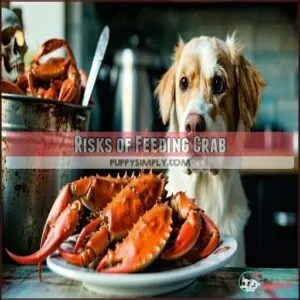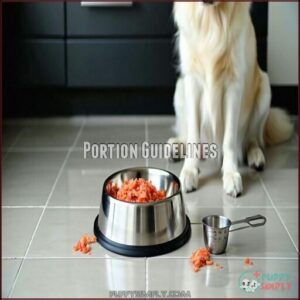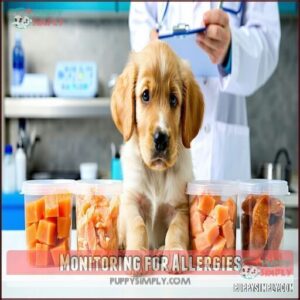This site is supported by our readers. We may earn a commission, at no cost to you, if you purchase through links.
 Yes, dogs can eat crab meat, but you’ll want to be careful.
Yes, dogs can eat crab meat, but you’ll want to be careful.
Cooked, plain crab meat offers great protein and omega-3s, but it’s not without risks.
Always remove shells to prevent choking, and cook the meat thoroughly to kill potential bacteria.
Start with tiny portions to check for allergic reactions, watching for symptoms like itching or stomach upset.
Some dogs might love this seafood treat, while others could have sensitivities.
Moderation is key—think of crab as an occasional snack, not a meal replacement.
Unsure about your pup’s tolerance? A quick chat with your vet can help you navigate this tasty seafood adventure safely.
Table Of Contents
- Key Takeaways
- Nutritional Benefits of Crab
- Can Dogs Eat Crab Meat
- Health Benefits of Crab
- Risks of Feeding Crab
- Safe Feeding Practices
- Types of Crab for Dogs
- Preparing Crab for Dogs
- Portion Guidelines
- Monitoring for Allergies
- Veterinary Advice
- Frequently Asked Questions (FAQs)
- Can dogs eat crab meat?
- Can crab meat be consumed as part of a diabetic diet?
- Can dogs eat crab legs?
- Is crab meat poisonous to dogs?
- Can dogs eat imitation crab meat?
- Can dogs get sick if they eat crabs?
- Is it safe to eat crab meat during pregnancy?
- Is crab beneficial for dogs?
- Can dogs eat cooked crab meat?
- Can dogs eat shrimp or crab?
- Conclusion
Key Takeaways
- You’ll want to serve crab meat cooked, shell-free, and in tiny portions to prevent choking and bacterial risks. Always inspect the meat carefully and remove all shells before feeding.
- Watch for potential allergic reactions when introducing crab, starting with small amounts and monitoring your dog for symptoms like itching, vomiting, or digestive upset. Not all dogs tolerate seafood the same way.
- Crab offers nutritional benefits like high-quality protein, omega-3 fatty acids, and essential vitamins that can support your dog’s muscle health, brain function, and coat shine. But it’s a treat, not a meal replacement.
- Always consult your veterinarian before adding crab to your dog’s diet, as they can provide personalized advice based on your dog’s breed, size, and individual health needs. Professional guidance ensures safe seafood consumption.
Nutritional Benefits of Crab
Crab meat is packed with high-quality protein, omega-3 fatty acids, and essential vitamins like B12, making it a nutritious treat for your dog.
A seafood adventure awaits—nutritious crab meat can support your pup’s health with every tasty, protein-packed bite.
These nutrients support muscle growth, brain function, and a shiny coat, helping keep your pup healthy.
High-Quality Protein Source
Crab meat is a fantastic lean protein for dog nutrition.
It’s packed with essential amino acids that boost muscle development, tissue repair, and immune support. Plus, its high protein bioavailability makes certain dogs absorb maximum nutrients.
The benefits of crab for dogs are clear:
- Builds strong muscles
- Supports tissue recovery
- Strengthens immune function
- Promotes overall health
Rich in Omega-3 Fatty Acids
Regarding dog health, omega-3 fatty acids are a game-changer.
Found in crab meat, these nutrients support joint health, reduce inflammation, and boost cognitive function.
Adding small amounts of cooked crab to your dog’s diet can enhance their skin and coat, making them shine like a star.
Omega-3 benefits don’t just stop there—they positively impact overall dog nutrition too!
However, shell injuries can pose a risk, so careful preparation is paramount.
Essential Vitamins and Minerals
A dog’s diet thrives on the rich nutritional value of crab, packed with essential vitamins and minerals.
Its B12 benefits support energy and brain health, while zinc importance boosts immunity and metabolism. Selenium sources help cellular health, and the copper function aids red blood cell production.
A true vitamin variety, crab nutrition for dogs enhances overall health.
- Boosts immunity with zinc.
- Supports brain health with vitamin B12.
- Improves cell function through selenium.
- Enhances metabolism with copper.
Can Dogs Eat Crab Meat
If you’re wondering, "Is crab safe for dogs?" the short answer is yes, but only with precautions.
Crab meat offers many benefits for dogs when cooked properly, but it’s not free from risks.
You’ll need to make certain it’s fully cooked, with every bit of shell removed—sharp shells can turn mealtime into a hazard quickly.
Small portions are key since some dogs may be sensitive to iodine or develop allergies.
Start small and monitor for reactions like itching or stomach upset.
For guidance, a vet consultation benefits both you and your pup by making certain of safety.
| Factor | Safe Practice | Risk |
|---|---|---|
| Cooking Crab Properly | Boil or steam | Raw crab has bacteria |
| Shell Removal Importance | Remove completely | Sharp fragments can cause injury |
| Allergy Monitoring Tips | Start with small amounts | Allergic reactions possible |
| Portion Size | 1-2 tablespoons at first | Overfeeding may cause diarrhea |
| Vet Consultation Benefits | Confirm dietary safety | Avoid health surprises |
Health Benefits of Crab
Crab meat is packed with nutrients like omega-3 fatty acids, vitamins, and minerals that can boost your dog’s heart health, brain function, and coat shine.
Adding small amounts of cooked, plain crab to their diet might just make their tails wag a little brighter!
Improves Heart Health
A little crab meat can do wonders for your pup’s heart health.
Thanks to omega-3 benefits, its fatty acids reduce inflammation and promote better blood flow. Taurine content also supports cardiovascular function, while healthy fats boost energy.
Just watch that cholesterol and sodium—too much isn’t great for canine health. Moderation is key to enjoying these benefits safely!
Supports Brain Function
Crab nutrition for dogs includes omega-3 fatty acids, vitamin B12, zinc, and taurine, which work wonders for cognitive health.
Omega-3 benefits include reducing brain inflammation and improving nerve function, while B12 supports brain and nerve cells. Zinc’s role helps enzymes in the brain function smoothly.
Taurine content promotes calmness, boosting your dog’s wellbeing. It’s brain food fit for a pup genius!
Promotes Skin and Coat Health
Speaking of brain health, crab nutrition for dogs also benefits their skin and coat.
Packed with omega-3 fatty acids and healthy fats, crab meat promotes coat shine and skin hydration.
These nutrients reduce inflammation, soothe itchy skin, and combat dryness. Vitamin B12 and zinc further enhance skin health, making crab a seafood treat that supports your dog’s outer glow.
Risks of Feeding Crab
Feeding crab to your dog isn’t always safe and can come with significant risks.
From sharp shells causing injuries to allergic reactions or bacterial contamination, it’s important to understand the dangers before sharing this seafood treat. Complete concepts and separate lines.
Choking Hazard From Shells
Sharp shells from crab can turn a tasty treat into a danger for dogs.
Shell ingestion leads to injuries like cuts in the mouth or worse—intestinal blockage.
Shell size also matters; smaller breeds face greater risks.
Play it safe with these tips:
- Inspect carefully: Remove all shells before serving.
- Know your breed: Smaller dogs are more vulnerable.
- Take emergency actions: Call your vet immediately for suspected choking.
Allergic Reactions and Symptoms
Allergic reactions in dogs eating crab can range from mild itching to severe symptoms like vomiting or anaphylaxis. Watch for signs, including red skin, hair loss, or excessive scratching.
| Reaction Severity | Symptoms | Treatment | Prevention Tips |
|---|---|---|---|
| Mild | Itchy skin, redness | Antihistamines, monitor | Test small portions |
| Moderate | Vomiting, diarrhea | Vet visit, hydration | Limit crab intake |
| Severe | Swelling, hives | Emergency intervention | Avoid crab if allergic signs appear |
| Life-threatening | Anaphylaxis | Immediate vet treatment | Consult vet before trying crab |
Always monitor your dog after crab exposure for potential allergies.
Remember that seafood toxicity is possible due to high iodine levels.
Bacterial Contamination in Raw Meat
Raw crab carries risks like Salmonella, E. coli concerns, and parasite exposure, which can harm your dog’s gastrointestinal tract.
Bacterial contamination isn’t worth the gamble.
Proper cooking temperatures kill off these dangers, ensuring food safety.
Always practice safe handling by washing your hands and utensils.
Skip raw crab entirely—your dog deserves cooked meals without these intestinal parasite risks!
Safe Feeding Practices
If you’re planning to share crab with your dog, it’s important to prepare it the right way to keep them safe.
Stick to well-cooked, plain, shell-free crab meat in small portions to avoid health risks.
Cooking Methods for Safety
Cooking methods matter for safe food preparation.
Boiling or steaming crab makes certain it’s dog-safe, as these methods avoid adding fats or seasonings that can harm your pup.
Baking? Use precautions—skip oils or spices.
Grilling? Focus on safety, avoiding charring.
Always cool crab completely before serving; hot crab’s no treat!
Stick to plain crab meat to keep it simple.
Proper handling requires safe crab preparation.
Removing Shells and Cartilage
Removing shells and cartilage is critical when preparing crab for dogs.
Shell ingestion can lead to mouth injuries or worse, intestinal blockages. Use proper tools for safe removal and perform a visual inspection to catch small fragments.
Don’t rush—shell identification takes patience. Cartilage concerns? Toss it out.
When you let your dog eat crab meat, make certain it’s perfectly clean. Cartilage, however, can offer glucosamine and chondroitin, beneficial for joint health.
Avoiding Seasonings and Additives
After carefully removing those pesky shells, you’ll want to keep your dog’s crab super plain.
Spices can turn a tasty treat into a health hazard faster than a tail wag.
Watch out for toxic seasonings that can spell trouble:
- Garlic powder triggers red flags
- Onion-based spices are dangerous
- Salt causes electrolyte imbalances
- Butter increases pancreatitis risk
- Artificial additives create digestive drama
Stick to pure, unadulterated crab meat for a safe, tail-wagging meal, and always avoid toxic seasonings.
Types of Crab for Dogs
In the context of feeding your furry friend crab, you’ll want to know which types are safe and nutritious.
Not all crab varieties are created equal, so understanding the differences between soft shell, canned, and imitation crab can help you make the best choice for your dog’s diet, considering the importance of nutritious food.
Soft Shell Crab
In the realm of crab for canines, soft shell crab offers a unique nutritional profile that might pique your pup’s interest.
Here’s a quick breakdown of what you need to know:
| Benefit | Taurine | B12 Content | Omega-3 |
|---|---|---|---|
| Level | High | Moderate | Excellent |
| Dog Impact | Brain Health | Metabolism | Skin/Coat |
| Digestibility | Good | Very Good | Excellent |
| Allergy Risk | Low | Low | Moderate |
| Recommended | Small Portions | Occasional | Monitored |
Soft shell crab can be a delicate treat when prepared properly, but always consult your vet first, considering the nutritional profile and potential allergy risk.
Canned Crab Meat
After exploring soft shell crab, let’s crack open the can of canned crab meat for your furry friend.
Not all canned seafood is created equal in terms of dog-friendly fare. Watch out for potential pitfalls:
- High sodium content can spell trouble
- Preservatives might trigger digestive issues
- Rinsing becomes your secret weapon
Choose wisely, and your pup’s safety comes first. You can even find canned crab options made specifically for dogs.
Imitation Crab
In the realm of dog treats, imitation crab stands out as a wolf in sheep’s clothing.
Processed from white fish with added sugars, preservatives, and artificial flavors, it’s nutritionally empty and potentially harmful.
While a tiny bite won’t spell disaster, the hidden dangers of sodium, additives, and low nutritional value make it a treat to avoid.
Stick to safer alternatives.
Preparing Crab for Dogs
If you’re considering adding crab to your dog’s diet, proper preparation is key to keeping your furry friend safe and healthy.
You’ll want to carefully cook the crab meat without seasonings, remove all shells, and serve it in small, plain portions to prevent potential health risks, ensuring a healthy diet.
Boiling and Steaming
After exploring soft shell crab options, you’ll want to master safe cooking techniques for your pup.
Boiling and steaming are top methods for preparing crab meat. Here’s what you need to know:
- Keep water temperatures between 145-165°F
- Steam for 3-5 minutes maximum
- Avoid adding salt or spices
- Drain thoroughly after cooking
- Cool meat completely before serving
For best results, consider using a specialized cooking tool to ensure complete and safe cooking.
Baking and Grilling
Occasionally, baking or grilling crab for dogs requires precise technique. Aim to cook crab meat at safe temperatures between 145-165°F to eliminate harmful bacteria.
Avoid adding seasonings that could upset your dog’s stomach. Pat the meat dry after cooking and let it cool completely.
Check for doneness without introducing potentially toxic marinades or spices, ensuring the safe temperatures are maintained throughout the process.
Serving Plain Crab Meat
At the intersection of nutrition and caution, serving plain crab meat to dogs requires a strategic approach.
Here’s how to do it right:
- Cook thoroughly without seasonings
- Remove all shells completely
- Cut into small, bite-sized pieces
- Limit to occasional treat status
- Monitor for any allergic reactions
Always prioritize your pup’s safety by consulting your veterinarian before introducing crab to their diet, and remember to handle this introduction with caution.
Portion Guidelines
Regarding feeding your dog crab meat, you’ll want to be precise about how much you serve based on your pup’s size.
Knowing the right portion guidelines will help you treat your furry friend safely while avoiding potential digestive issues or allergic reactions, which is crucial for your dog’s health and well-being.
Small Breeds
Just around the corner from potential health risks lies a delightful treat for small dog owners: crab meat.
For pups weighing 21-30 pounds, like Beagles and Miniature American Shepherds, you can safely serve 2-3 tablespoons of well-cooked, shell-free crab once or twice weekly.
| Dog Breed Size | Crab Portion | Frequency |
|---|---|---|
| Small (21-30 lbs) | 2-3 Tbsp | 1-2x/week |
| Breed Examples | Beagles, Miniature Shepherds | Moderate |
| Preparation | Fully Cooked, No Shells | Essential |
| Monitoring | Watch for Allergies | Vital |
| Veterinary Advice | Consult Before Feeding | Recommended |
Medium Breeds
If your medium-sized pup weighs between 31-50 pounds, you’ve got a green light for crab treats!
These dogs can enjoy up to ¼ cup of well-cooked, shell-free crab meat once or twice weekly.
Considering their activity levels and dietary needs, monitor portion control and watch for any digestive quirks.
Always consult your vet to confirm this seafood snack fits your dog’s individual health profile.
Large Breeds
If you’ve got a big buddy like a Pit Bull or German Shepherd, crab meat can be a tasty treat that supports joint health.
Large dogs (51–90 pounds) can enjoy up to ½ cup of well-cooked, shelled crab once or twice weekly.
Ideal feeding practices help prevent developmental orthopedic diseases in large breeds.
Watch their energy levels and digestive system load, ensuring the serving size aligns with their breed-specific needs and supports overall joint health.
Monitoring for Allergies
When introducing crab to your dog’s diet, you’ll want to be on high alert for any unusual reactions that might signal an allergy.
Watch for symptoms like itching, swelling, or digestive upset, and always start with a tiny portion to guarantee your furry friend tolerates this new treat safely.
Identifying Symptoms
After carefully monitoring portion sizes for your pup, watch for signs of a crab meat allergy.
Itching, skin rashes, and swelling might signal an allergic reaction. Keep an eye out for vomiting, diarrhea, and sudden lethargy.
If your dog shows gastrointestinal upset after eating crab, stop feeding immediately and contact your veterinarian for guidance.
Treating Allergic Reactions
When a crab allergy strikes your dog, swift action is key.
Start by identifying allergens and administering the right antihistamine dosage. Your vet might recommend steroid use for severe reactions.
Keep emergency care contact info handy, and watch for symptoms like swelling or breathing difficulties.
Always prioritize a vet follow-up to guarantee your pup’s complete recovery and rule out serious complications.
Preventing Allergies
After spotting allergic symptoms in your pup, shifting gears to prevention is smart.
Protecting your furry friend from potential allergic reactions requires strategic planning. Here’s how to keep those tail-wagging days allergy-free:
- Start with tiny, carefully measured crab portions
- Watch for any unusual reactions closely
- Document every response painstakingly
- Trust your veterinarian’s expert guidance
Veterinary Advice
Before introducing crab to your dog’s diet, you’ll want to consult your veterinarian for personalized guidance.
They’ll help you determine if crab is safe for your furry friend and can provide specific recommendations based on your dog’s individual health needs and potential sensitivities, ensuring a safe introduction to crab.
Consultation Before Feeding
Before diving into the crab feast, schedule a chat with your vet.
They’ll offer personalized veterinary advice suited to your dog’s individual needs, considering canine nutrition and potential health risks.
Professional guidance guarantees dietary safety, helping you navigate your pup’s unique dietary requirements and avoid unnecessary complications with pet nutrition.
Determining Safe Consumption
After consulting your vet, determining safe crab consumption involves careful observation.
Start with tiny amounts of cooked, shell-free crab meat. Watch for signs of allergic reactions like itching or upset stomach.
Different dogs tolerate seafood differently. Consider your dog’s size, health history, and individual sensitivities when introducing this protein-rich treat.
Alternative Treats and Foods
If your vet suggests steering clear of crab, don’t worry! You’ve got plenty of safe, delicious alternatives.
Lean proteins like boiled chicken and turkey deli meat make fantastic dog treats.
Try veggie options such as green beans or carrots, and fruit treats like blueberries.
Homemade diets can include dogsafe ingredients like cooked oatmeal or pumpkin, ensuring your pup stays healthy and happy.
Frequently Asked Questions (FAQs)
Can dogs eat crab meat?
Yes, dogs can eat crab meat, but it’s essential to serve it cooked, shell-free, and in moderation.
Watch for allergic reactions and consult your vet before adding this seafood treat to your pup’s diet.
Can crab meat be consumed as part of a diabetic diet?
Crab meat can fit into a diabetic diet when consumed in moderation.
It’s low in carbs, high in protein, and provides essential nutrients.
However, you’ll want to monitor portion sizes and prepare it without added fats or sugars, which is crucial for a diabetic diet.
Can dogs eat crab legs?
Like walking a tightrope, feeding crab legs to dogs requires caution.
Those sharp shells can slice through your pup’s delicate insides.
Always remove shells, cook thoroughly, and serve tiny portions—and check with your vet first.
Is crab meat poisonous to dogs?
Crab meat isn’t poisonous, but it’s not without risks.
You’ll want to serve it cooked, shell-free, and in small amounts.
Some dogs might be allergic, so always watch for reactions and consult your veterinarian first.
Can dogs eat imitation crab meat?
You shouldn’t feed your dog imitation crab meat.
It’s packed with additives, sugar, and sodium that can upset their stomach.
Stick to real, plain, cooked crab meat in moderation, and always consult your vet first.
Can dogs get sick if they eat crabs?
Dogs can suffer serious health risks from eating raw crabs, including parasitic infections, gastrointestinal injuries from sharp shells, and potential allergic reactions that might trigger painful digestive complications.
Is it safe to eat crab meat during pregnancy?
Studies show 20% of pregnant women worry about seafood safety.
You’ll want to choose low-mercury crab varieties, cook thoroughly, and limit portions.
Consult your healthcare provider to navigate safe seafood choices during pregnancy.
Is crab beneficial for dogs?
You’ll find crab can be a nutritious treat when prepared carefully.
Cooked, shell-free meat offers protein and omega-3s, but serve sparingly.
Always consult your vet and watch for allergic reactions before adding it to Fido’s diet, considering omega-3s.
Can dogs eat cooked crab meat?
You can serve your pup cooked, shell-free crab meat in small amounts, but first check with your vet.
Watch for allergic reactions and stick to plain, thoroughly cooked crab as an occasional treat.
Can dogs eat shrimp or crab?
Like a cautious chef tasting a new recipe, you’ll want to be careful with seafood.
Cooked shrimp and crab can be safe treats in moderation, but always remove shells, introduce slowly, and consult your vet first, to ensure a safe experience.
Conclusion
Ultimately, can dogs eat crab meat safely? Yes, but with caution.
You’ll want to start small, watching for any allergic reactions or digestive issues.
Plain, thoroughly cooked crab offers nutritional benefits, but moderation is essential.
Always remove shells, avoid seasonings, and consult your vet first.
By following these guidelines, you can introduce this protein-rich treat to your pup’s diet.
Remember, every dog is different, so pay attention to your furry friend’s individual response.



















